英语四种时态
- 格式:doc
- 大小:43.00 KB
- 文档页数:1
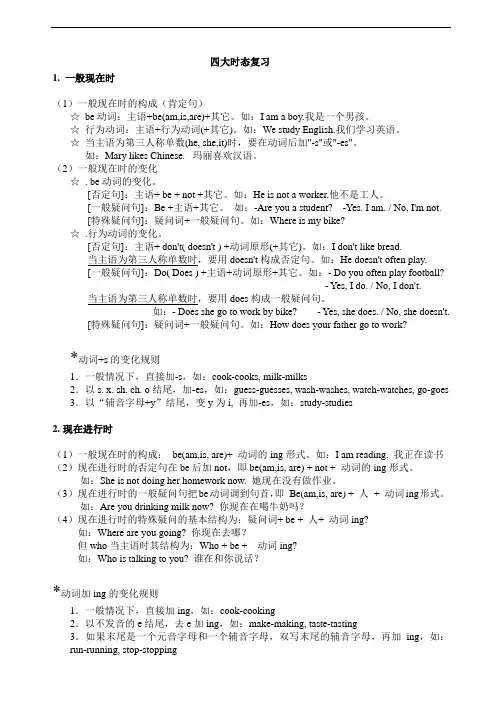
四大时态复习1. 一般现在时(1)一般现在时的构成(肯定句)☆be动词:主语+be(am,is,are)+其它。
如:I am a boy.我是一个男孩。
☆行为动词:主语+行为动词(+其它)。
如:We study English.我们学习英语。
☆当主语为第三人称单数(he, she,it)时,要在动词后加"-s"或"-es"。
如:Mary likes Chinese. 玛丽喜欢汉语。
(2)一般现在时的变化☆. be动词的变化。
[否定句]:主语+ be + not +其它。
如:He is not a worker.他不是工人。
[一般疑问句]:Be +主语+其它。
如:-Are you a student? -Yes. I am. / No, I'm not.[特殊疑问句]:疑问词+一般疑问句。
如:Where is my bike?☆.行为动词的变化。
[否定句]:主语+ don't( doesn't ) +动词原形(+其它)。
如:I don't like bread.当主语为第三人称单数时,要用doesn't构成否定句。
如:He doesn't often play.[一般疑问句]:Do( Does ) +主语+动词原形+其它。
如:- Do you often play football?- Yes, I do. / No, I don't.当主语为第三人称单数时,要用does构成一般疑问句。
如:- Does she go to work by bike? - Yes, she does. / No, she doesn't.[特殊疑问句]:疑问词+一般疑问句。
如:How does your father go to work?*动词+s的变化规则1.一般情况下,直接加-s,如:cook-cooks, milk-milks2.以s. x. sh. ch. o结尾,加-es,如:guess-guesses, wash-washes, watch-watches, go-goes 3.以“辅音字母+y”结尾,变y为i, 再加-es,如:study-studies2.现在进行时(1)一般现在时的构成:be(am,is, are)+ 动词的ing形式。
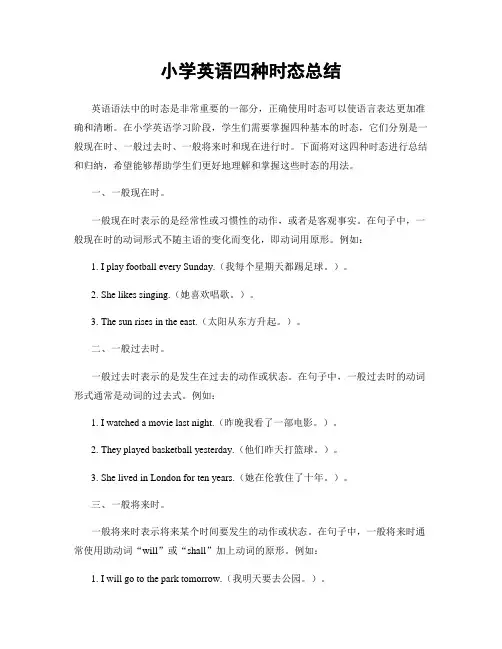
小学英语四种时态总结英语语法中的时态是非常重要的一部分,正确使用时态可以使语言表达更加准确和清晰。
在小学英语学习阶段,学生们需要掌握四种基本的时态,它们分别是一般现在时、一般过去时、一般将来时和现在进行时。
下面将对这四种时态进行总结和归纳,希望能够帮助学生们更好地理解和掌握这些时态的用法。
一、一般现在时。
一般现在时表示的是经常性或习惯性的动作,或者是客观事实。
在句子中,一般现在时的动词形式不随主语的变化而变化,即动词用原形。
例如:1. I play football every Sunday.(我每个星期天都踢足球。
)。
2. She likes singing.(她喜欢唱歌。
)。
3. The sun rises in the east.(太阳从东方升起。
)。
二、一般过去时。
一般过去时表示的是发生在过去的动作或状态。
在句子中,一般过去时的动词形式通常是动词的过去式。
例如:1. I watched a movie last night.(昨晚我看了一部电影。
)。
2. They played basketball yesterday.(他们昨天打篮球。
)。
3. She lived in London for ten years.(她在伦敦住了十年。
)。
三、一般将来时。
一般将来时表示将来某个时间要发生的动作或状态。
在句子中,一般将来时通常使用助动词“will”或“shall”加上动词的原形。
例如:1. I will go to the park tomorrow.(我明天要去公园。
)。
2. She shall visit her grandparents next week.(她下周要去看望她的祖父母。
)。
3. We will have a party on Friday.(我们星期五要举办派对。
)。
四、现在进行时。
现在进行时表示现在正在进行的动作,或者是现阶段正在发生的动作。
在句子中,现在进行时的动词形式是“be”动词的现在分词形式。
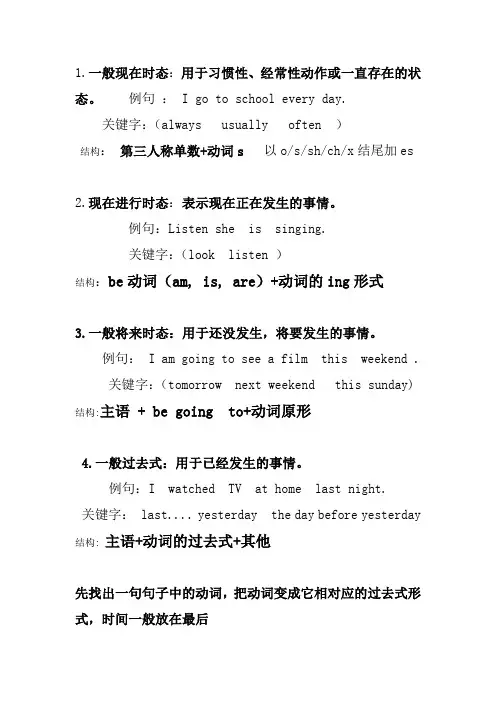
1.一般现在时态:用于习惯性、经常性动作或一直存在的状态。
例句: I go to school every day.
关键字:(always usually often )
结构:第三人称单数+动词s 以o/s/sh/ch/x结尾加es
2.现在进行时态:表示现在正在发生的事情。
例句:Listen she is singing.
关键字:(look listen )
结构:be动词(am, is, are)+动词的ing形式
3.一般将来时态:用于还没发生,将要发生的事情。
例句: I am going to see a film this weekend .
关键字:(tomorrow next weekend this sunday) 结构:主语+ be going to+动词原形
4.一般过去式:用于已经发生的事情。
例句:I watched TV at home last night.
关键字: last.... yesterday the day before yesterday 结构: 主语+动词的过去式+其他
先找出一句句子中的动词,把动词变成它相对应的过去式形式,时间一般放在最后。
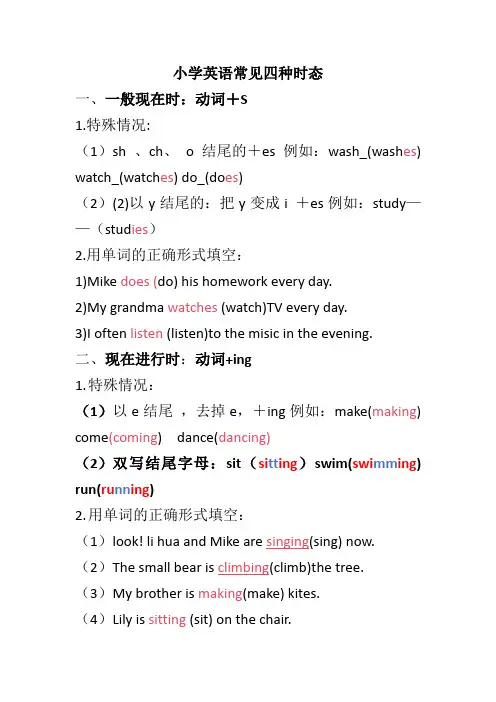
小学英语常见四种时态一、一般现在时:动词+S1.特殊情况:(1)sh 、ch、o结尾的+es例如:wash_(wash es) watch_(watch es) do_(do es)(2)(2)以y结尾的:把y变成i +es例如:study——(stud ies)2.用单词的正确形式填空:1)Mike does (do) his homework every day.2)My grandma watches (watch)TV every day.3)I often listen (listen)to the misic in the evening.二、现在进行时:动词+ing1.特殊情况:(1)以e结尾,去掉e,+ing例如:make(making) come(coming) dance(dancing)(2)双写结尾字母:sit(si tt ing)swim(swi mm ing) run(ru nn ing)2.用单词的正确形式填空:(1)look! li hua and Mike are singing(sing) now.(2)The small bear is climbing(climb)the tree.(3)My brother is making(make) kites.(4)Lily is sitting (sit) on the chair.三、一般过去时:动词+ed1.特殊情况:(1)有e结尾的,直接+ d例如:like(liked) live(lived)(2)有y结尾的,把y变成+ed 例如:cry(cried)study(studied)(3)不规则变化eat(ate) get(got) see(saw) spend(spent) do(did) teach(taught) win(won) write(wrote) buy (bought) swim(swam)go(went) meet(met) are(were) is(was) am(was)2.用单词的正确形式填空:(1).Did you water the flower yesterday.(2)L i Hua went(go) for a walk last Sunday.(3)M ike didn’t finish (finish)his homework yesterday.(4)I picked apples on the tree last month.四、一般将来时:(1)Shall/will +动词原形(shall只能用于第一人称I /we shall)(2)be going to +动词原形(表示打算做什么)be going to+地点(表示准备去)例如:1.I am going to see a film tomrrow.2There will be a party in our school3.Mike will visit his grandpa next week.。
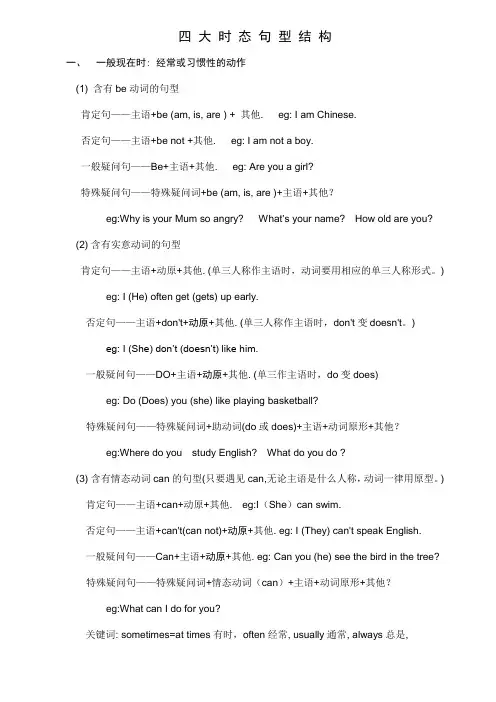
四大时态句型结构一、一般现在时: 经常或习惯性的动作(1) 含有be动词的句型肯定句——主语+be (am, is, are ) + 其他. eg: I am Chinese.否定句——主语+be not +其他. eg: I am not a boy.一般疑问句——Be+主语+其他. eg: Are you a girl?特殊疑问句——特殊疑问词+be (am, is, are )+主语+其他?eg:Why is your Mum so angry? What’s your name? How old are you? (2) 含有实意动词的句型肯定句——主语+动原+其他. (单三人称作主语时,动词要用相应的单三人称形式。
) eg: I (He) often get (gets) up early.否定句——主语+don't+动原+其他. (单三人称作主语时,don't变doesn't。
) eg: I (She) don’t (doesn’t) like him.一般疑问句——DO+主语+动原+其他. (单三作主语时,do变does)eg: Do (Does) you (she) like playing basketball?特殊疑问句——特殊疑问词+助动词(do或does)+主语+动词原形+其他?eg:Where do you study English? What do you do ?(3) 含有情态动词can的句型(只要遇见can,无论主语是什么人称,动词一律用原型。
)肯定句——主语+can+动原+其他. eg:I(She)can swim.否定句——主语+can't(can not)+动原+其他. eg: I (They) can't speak English.一般疑问句——Can+主语+动原+其他. eg: Can you (he) see the bird in the tree?特殊疑问句——特殊疑问词+情态动词(can)+主语+动词原形+其他?eg:What can I do for you?关键词: sometimes=at times有时,often经常, usually通常, always总是,every day每天, on Sunday afternoon在周日下午, five days a week一周五天, three times a month一个月三次…二、现在进行时: 正在发生的动作或存在的状态肯定句——主语+be+动词的现在分词(ing)+其他. eg: I am reading now.否定句——主语+be not+动词的现在分词(ing)+其他. eg: I am not working.一般疑问句——Be +主语+动词的现在分词(ing)+其他? eg: Are you sleeping?特殊疑问句——特殊疑问词+ be +主语+动词的现在分词(ing)+其他?eg:What are you doing?关键词:now现在, at the moment此刻, look, listen, keep quiet等提示语.三、一般将来时: 将要发生的动作(1)含有will的句型肯定句——主语+will+动词原型+其他. eg: I will call you later.否定句——主语+will not +动词原型+其他. eg: I will not go to the park.一般疑问句——Will +主语+动词原型+其他. Will you go shopping with her?特殊疑问句——特殊疑问词+will +主语+动词原形+其它?(will 可改为be going to ,疑问句中当主语是第一人称时will改为shall)(2)含有be going to 的句型肯定句——主语+be(am / is / are) + going to +动词原形+其它.否定句——主语+be(am / is / are)+not + going to +动词原形+其它.一般疑问句——Be(am / is / are) +主语+ going to +动词原形+其它?特殊疑问句——特殊疑问词+ be(am / is / are) +主语+ going to +动词原形+其它?关键词:tomorrow, next year明年, tonight今晚, this year今年, at the end of this term这学期期末, from now on从现在开始, soon一会儿马上, later后稍后,in three days三天之内, in the future未来…四、一般过去时: 过去发生的动作强调时间(1)含有be动词的句型肯定句——主语+be(was,were)+其他. eg: I was born on July.1st, 2000.否定句——主语+be(was,were) not+其他. eg: I was not born in 1999.一般疑问句—Be(was,were)+主语+其他? eg: Were you born in January?特殊疑问句—特殊疑问词+ be(was,were)+主语+其他. eg: When was he born?(2)含有实意动词过去式的句型肯定句——主语+动词的过去式+其他. eg: Lily went shopping yesterday.否定句——主语+did not+动原+其他. eg: He did not go to school today.一般疑问句——Did+主语+动原+其他? eg:Did she pass the test?特殊疑问句—特殊疑问词+did+主语+动原+其他. eg:Where did you go yesterday?关键词:yesterday昨天,last week上周, last year去年, 一段时间+ago如ten years ago十年前five hours ago五小时前, in +年/月,on+具体日期...Just now=a moment ago刚才,in the old days从前, long ago很久以前...。
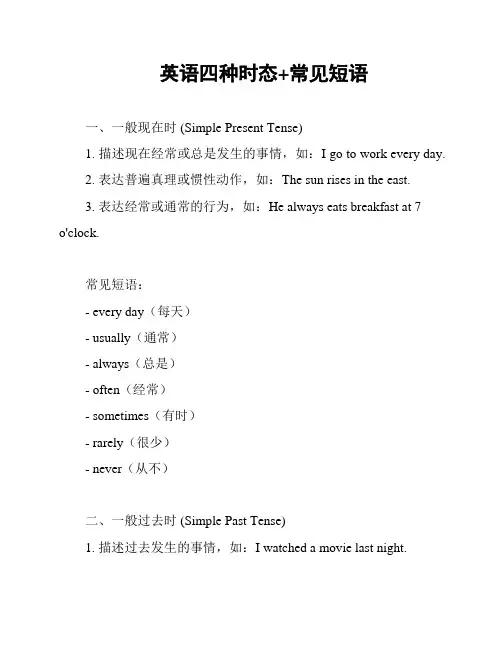
英语四种时态+常见短语一、一般现在时 (Simple Present Tense)1. 描述现在经常或总是发生的事情,如:I go to work every day.2. 表达普遍真理或惯性动作,如:The sun rises in the east.3. 表达经常或通常的行为,如:He always eats breakfast at 7o'clock.常见短语:- every day(每天)- usually(通常)- always(总是)- often(经常)- sometimes(有时)- rarely(很少)- never(从不)二、一般过去时 (Simple Past Tense)1. 描述过去发生的事情,如:I watched a movie last night.2. 表达过去常常发生的动作,如:He often went fishing when he was young.3. 表达过去的惯,如:We lived in that house for many years.常见短语:- yesterday(昨天)- last night(昨晚)- a week ago(一周前)- in the past(在过去)- when I was young(在我年轻的时候)- for many years(多年来)- in those days(在那些日子里)三、一般将来时 (Simple Future Tense)1. 表达将来会发生的事情,如:I will visit my grandparents next week.2. 表示打算或计划做的事情,如:We are going to have a party on Saturday.3. 表达预测的事件,如:I think he will win the game.常见短语:- next week(下周)- in the future(在未来)- tomorrow(明天)- on Saturday(在星期六)- be going to(打算)- will(将)- I think(我认为)四、现在进行时 (Present Continuous Tense)1. 描述现在正在发生的事情,如:She is studying in the library right now.2. 表达将来安排好的事情,如:We are leaving for a vacation next month.3. 表示暂时的情况,如:He is living with his sister while his house is being renovated.常见短语:- right now(现在)- at the moment(此刻)- in the near future(不久的将来)- next month(下个月)- while(在...期间)- currently(目前)- at present(现在)以上是英语中四种常见的时态以及常见的短语,掌握这些时态和短语可以帮助你更准确地表达过去、现在和将来的事件和状态。
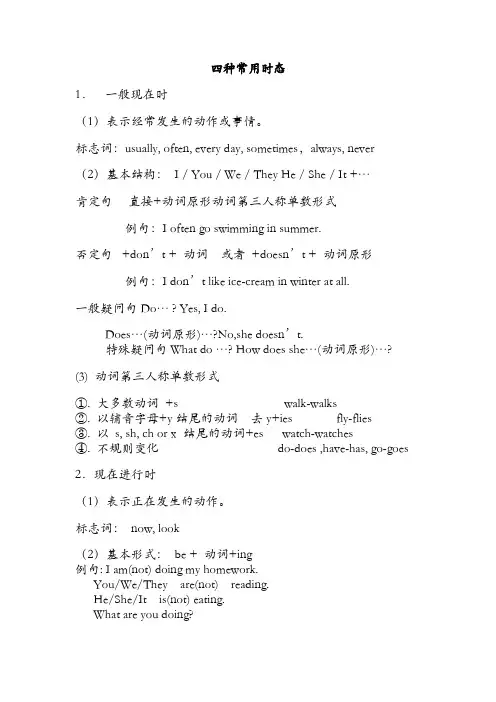
四种常用时态1.一般现在时(1)表示经常发生的动作或事情。
标志词:usually, often, every day, sometimes,always, never (2)基本结构:I / You / We / They He / She / It +…肯定句直接+动词原形动词第三人称单数形式例句:I often go swimming in summer.否定句+don’t + 动词或者+doesn’t + 动词原形例句:I don’t like ice-cream in winter at all.一般疑问句Do… ? Yes, I do.Does…(动词原形)…?No,she doesn’t.特殊疑问句What do …? How does she…(动词原形)…?(3) 动词第三人称单数形式①. 大多数动词+s walk-walks②. 以辅音字母+y结尾的动词去y+ies fly-flies③. 以s, sh, ch or x 结尾的动词+es watch-watches④. 不规则变化do-does ,have-has, go-goes 2.现在进行时(1)表示正在发生的动作。
标志词:now, look(2)基本形式:be + 动词+ing例句: I am(not) doing my homework.You/We/They are(not) reading.He/She/It is(not) eating.What are you doing?Is he reading?(3)动词的现在分词形式(do+ing)①. 大多数动词+ing walk—walking②. 以e结尾的动词去e+ing come—coming③. 重读闭音节单词,末尾只有一个辅音字母双写最后一个辅音字母再+ing run-running swim-swimming 3. 一般过去时态(1)表示过去已经发生的事情。
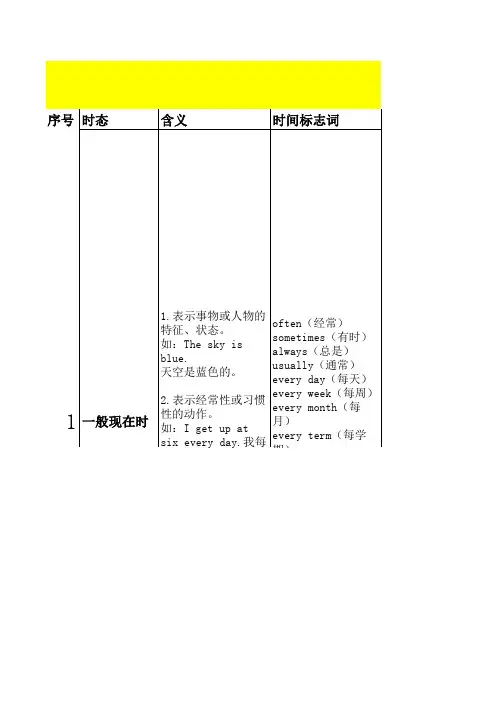

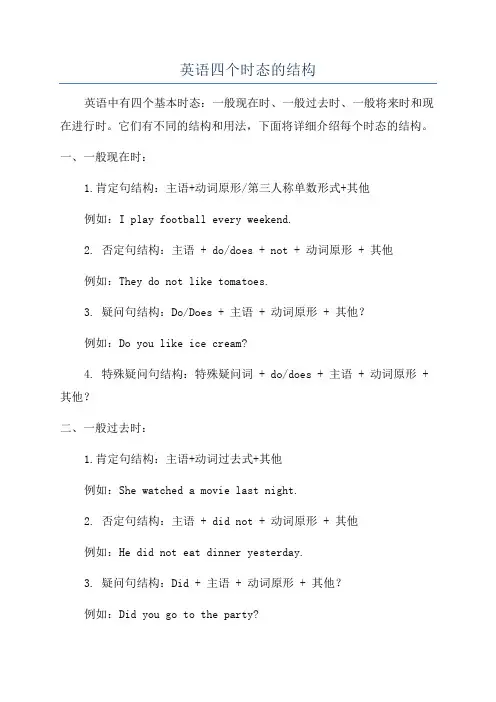
英语四个时态的结构英语中有四个基本时态:一般现在时、一般过去时、一般将来时和现在进行时。
它们有不同的结构和用法,下面将详细介绍每个时态的结构。
一、一般现在时:1.肯定句结构:主语+动词原形/第三人称单数形式+其他例如:I play football every weekend.2. 否定句结构:主语 + do/does + not + 动词原形 + 其他例如:They do not like tomatoes.3. 疑问句结构:Do/Does + 主语 + 动词原形 + 其他?例如:Do you like ice cream?4. 特殊疑问句结构:特殊疑问词 + do/does + 主语 + 动词原形 + 其他?二、一般过去时:1.肯定句结构:主语+动词过去式+其他例如:She watched a movie last night.2. 否定句结构:主语 + did not + 动词原形 + 其他例如:He did not eat dinner yesterday.3. 疑问句结构:Did + 主语 + 动词原形 + 其他?例如:Did you go to the party?4. 特殊疑问句结构:特殊疑问词 + did + 主语 + 动词原形 + 其他?例如:When did you arrive?三、一般将来时:1. 肯定句结构:主语 + will + 动词原形 + 其他例如:I will visit my grandma next week.2. 否定句结构:主语 + will not + 动词原形 + 其他3. 疑问句结构:Will + 主语 + 动词原形 + 其他?例如:Will you go to the concert?4. 特殊疑问句结构:特殊疑问词 + will + 主语 + 动词原形 + 其他?例如:Where will you travel next summer?四、现在进行时:1. 肯定句结构:主语 + am/is/are + 动词-ing + 其他例如:She is watching TV now.2. 否定句结构:主语 + am/is/are + not + 动词-ing + 其他例如:They are not studying for the exam.3. 疑问句结构:Am/Is/Are + 主语 + 动词-ing + 其他?例如:Are you playing basketball?4. 特殊疑问句结构:特殊疑问词 + am/is/are + 主语 + 动词-ing + 其他?例如:What are you doing tonight?以上就是英语四个基本时态的结构和用法。

千里之行,始于足下。
小学四种英语时态的归纳总结小学英语时态的归纳总结在小学阶段学习英语,掌握四种基本的时态是非常重要的。
这四种时态分别是一般现在时、一般过去时、一般将来时和现在进行时。
以下是对这四种时态的归纳总结。
一、一般现在时(Simple Present Tense)1. 表示经常性的动作或状态。
例如:I play basketball every Saturday.2. 在陈述句中,主语和动词要一致。
例如:He likes to watch movies.3. 在否定句中,用do / does + not + 动词原形。
例如:She does not like vegetables.4. 在疑问句中,用do / does + 主语 + 动词原形?例如:Do you have any pets?5. 用于表示客观事实、经验等。
二、一般过去时(Simple Past Tense)1. 表示过去发生的动作或状态。
例如:I watched a movie yesterday.2. 在陈述句中,动词过去式的变化规则是直接加-ed。
例如:We played soccer last week.3. 在否定句中,用did + not + 动词原形。
例如:She did not go to school yesterday.4. 在疑问句中,用did + 主语 + 动词原形?例如:Did you finishyour homework?第1页/共3页锲而不舍,金石可镂。
三、一般将来时(Simple Future Tense)1. 表示将来发生的动作或状态。
例如:I will go to the park tomorrow.2. 在陈述句中,用will / shall + 动词原形。
例如:She will visither grandparents next week.3. 在否定句中,用will not / won't + 动词原形。
小学英语四种时态1.一般现在时态概念:表示经常发生的或习惯性的动作或目前的状态。
规律:一般用动词原形,当主语为第三人称单数的一般现在时,动词要加s ,es ,标志性的单词:always ,usually ,often ,sometimes 如:She usually goes to school on foot2.现在进行时态概念:表示说话时正在发生或进行着的动作。
规律:be 动词ing 形式。
标志性的单词:look ,now ,listen 如:Look ,the boy is playing football 。
3.一般将来时态概念:表示将来发生的动作或情况。
规律:be going to do ,will do 。
标志性的单词:tomorrow ,the day after tomorrow ,next Sunday … 如:Mr Brown is going to visit Hong Kong tomorrow 。
4.一般过去时态概念:表示过去某一时刻或某一时间内发生的动作或情况。
标志性的单词:yesterday ,last Monday ,before ,ago,the day before yesterday 规律:(1)一般情况动词后面加ed ; 如:worked ,cleaned ,washed ,(2)以不发音e结尾的动词加d就要以了; 如:lived ,moved ,loved(3)以辅音加y结尾的动词把y改成i再加ed ; 如:study– studied ,carry—carried(4)重读闭音节的动词要双写末尾的辅音字母再加ed; 如:stop—stopped shop—shopped skip--- skipped(5)特殊变化:见不规则动词表。
小学英语固定搭配Good night 晚安.in the morning 在早上at noon 在中午in the afternoon 在下午in the evening 在傍晚at night 在夜间have/eat breakfast 吃早饭have/eat lunch 吃午饭have/eat supper(dinner) 吃晚饭read a book 读书sing a song 唱歌have a meeting 开会have class 上课have a party 聚会have a competition 竞赛have a sleep 睡觉have a snack 吃零食have a picnic 野餐have a buffet dinner 吃自助餐draw pictures 画画listen to music 听音乐listen to the radio 听收音机learn English 学习英语learn Chinese 学习语文Learn math 学习数学tell stories 讲故事take a walk 散步ask and answer questions 问答问题fly a kite 放风筝ride a bike 骑自行车ride a horse 骑马play computer games 玩电脑游戏play games 做游戏play hide and seek 玩捉迷藏do homework 做作业watch TV 看电视take a shower 洗淋浴take a bath 洗澡open the door 开门open the window 开窗户close the door 关门close the window 关窗户paly football 踢足球/打橄榄球play basketball 打篮球play volleyball 打排球play badminton 打羽毛球play golf 打高尔夫球play bowling 打保龄球play table tennis 打乒乓球play baseball 打棒球play tennis 打网球play soccer 踢足球play hockey 打曲棍球play chess 下棋go fishing 去钓鱼go swimming 去游泳go shopping 去购物go skating 去滑冰go bike-riding/ go cycling 去骑自行车go sking 去滑雪go camping 去野营listen to the news 听新闻read the newspaper 看报read the magazine 看杂志go to school 去上学go home 回家go to the park 去公园go to the zoo 去动物园go to the library 去图书馆go to the hospital 去医院go to the cinema 去电影院go to see a film /movie去看电影get up 起床go to bed 上床go to sleep 去睡觉brush the teeth 刷牙wash the hands 洗手wash the face 洗脸wash clothes 洗衣服air the room 给房间通风make the bed 铺床sweep the floor 扫地mop the floor 拖地clean the room 打扫房间climb the trees 爬树climb the mountains 爬山cook the meals 做饭drink milk/juice/coca cola 喝牛奶/果汁/可乐play the piano 弹钢琴play the violin 拉小提琴play the drum 打鼓play the guitar 弹吉他play the xylophone 弹木琴play the flute 吹笛子play the harp 弹竖琴play the erhu 拉二胡play the zither 弹古筝play the banjo 弹班卓play the trumpet 吹小号stay at home 呆在家里at home 在家at school 在学校at church 在教堂make a cake 做蛋糕take pictures/photos 照相comb hair 梳头发have a haircut 理发go away 走开at the weekend 在周末stand up 起立sit down 坐下New year 元旦Spring Festival 春节Lantern Festival 元宵节Spring Cleaning Day 清明节Dragon Boat Festival 龙舟节International labour day 国际劳动节Trees planting day 植树节Children's day 儿童节Party's day 党的生日Army's day 建军节Teacher's day 教师节National day 国庆节Thanksgiving day 感恩节Chrismas day 圣诞节in the morning 在早上at noon 在中午in the afternoon 在下午in the evening 在傍晚at night 在夜间have/eat breakfast 吃早饭have/eat lunch 吃午饭have/eat supper(dinner) 吃晚饭read a book 读书sing a song 唱歌have a meeting 开会have class 上课have a party 聚会have a competition 竞赛have a sleep 睡觉have a snack 吃零食have a picnic 野餐have a buffet dinner 吃自助餐draw pictures 画画listen to music 听音乐listen to the radio 听收音机learn English 学习英语learn Chinese 学习语文Learn math 学习数学tell stories 讲故事take a walk 散步ask and answer questions 问答问题fly a kite 放风筝ride a bike 骑自行车ride a horse 骑马play computer games 玩电脑游戏play games 做游戏play hide and seek 玩捉迷藏do homework 做作业watch TV 看电视take a shower 洗淋浴take a bath 洗澡open the door 开门open the window 开窗户close the door 关门close the window 关窗户paly football 踢足球/打橄榄球play basketball 打篮球play volleyball 打排球play badminton 打羽毛球play golf 打高尔夫球play bowling 打保龄球play table tennis 打乒乓球play baseball 打棒球play tennis 打网球play soccer 踢足球play hockey 打曲棍球play chess 下棋go fishing 去钓鱼go swimming 去游泳go shopping 去购物go skating 去滑冰go bike-riding/ go cycling 去骑自行车go sking 去滑雪go camping 去野营listen to the news 听新闻read the newspaper 看报read the magazine 看杂志go to school 去上学go home 回家go to the park 去公园go to the zoo 去动物园go to the library 去图书馆go to the hospital 去医院go to the cinema 去电影院go to see a film /movie去看电影get up 起床go to bed 上床go to sleep 去睡觉brush the teeth 刷牙wash the hands 洗手wash the face 洗脸wash clothes 洗衣服air the room 给房间通风make the bed 铺床sweep the floor 扫地mop the floor 拖地clean the room 打扫房间climb the trees 爬树climb the mountains 爬山cook the meals 做饭drink milk/juice/coca cola 喝牛奶/果汁/可乐play the piano 弹钢琴play the violin 拉小提琴play the drum 打鼓play the guitar 弹吉他play the xylophone 弹木琴play the flute 吹笛子play the harp 弹竖琴play the erhu 拉二胡play the zither 弹古筝play the banjo 弹班卓play the trumpet 吹小号stay at home 呆在家里at home 在家at school 在学校at church 在教堂make a cake 做蛋糕take pictures/photos 照相comb hair 梳头发have a haircut 理发go away 走开at the weekend 在周末stand up 起立sit down 坐下New year 元旦Spring Festival 春节Lantern Festival 元宵节Spring Cleaning Day 清明节Dragon Boat Festival 龙舟节International labour day 国际劳动节Trees planting day 植树节Children's day 儿童节Party's day 党的生日Army's day 建军节Teacher's day 教师节National day 国庆节小学英语动词过去式agree 同意agreedask 问askedanswer 回答answeredbecome 成为becamebegin 开始beganbring 带来broughtbuy 买boughtcall 呼叫calledcarry 搬运carriedcatch 抓住caughtcheck 检查checkedclean 清洁cleanedclimb 爬climbedcome 来camecook 煮cookedcut 切cutdance 跳舞danceddo 做diddraw 画drewdrink 喝drankdrive 驾驶droveeat 吃ateenjoy 欣赏enjoyedfeel 感觉feltfly 飞fliedforget 忘记forgotfish 钓鱼fishedget 得到gotgive 给gavego 去wentgrow 成长grewhave 有hadhear 听到heardhelp 帮助helpedjump 跳jumpedkeep 保存keptknow 知道knewlearn 学习learned listen 听listenedlike 喜欢likedlook 看lookedlive 生活livedlove 喜爱lovedmake 做mademeet 遇见metmove 移动moved need 需要needed open 打开opened paint 画paintedpick 摘pickedplay 玩playedplan 计划planned practise 练习practised prefer 更喜欢preferred put 放putread 读readride 骑roderun 跑ransay 说saidsee 看sawsit 坐satskip 跳skippedspeak 说spokestart 开始startedstay 停留stayed sweep 扫sweptstudy 学习studied swim 游泳swamtalk 谈话talkedtake 带去tookteach 教taughtthank 谢谢thanked tell 告诉toldthink 想thought travel 旅游traveledtry 试trieduse 使用used wake 醒来woke walk 走路walked want 想wanted wash 洗washed watch 看watched water 浇水watered wave 挥动waved work 工作worked worry 担心worried write 写wrote小学英语可数名词复数形式1)以y结尾的专有名词,或元音字母+y 结尾的名词变复数时,直接加s变复数。
英语的四大时态用法及结构英语中的时态共有四种,分别是一般现在时、一般过去时、一般将来时和现在完成时,它们各自有着不同的用法和结构。
一、一般现在时一般现在时表示现在的状态、经常发生的事情或普遍真理等,其结构为“主语+动词原形”。
例如:I go to school every day.(我每天去上学。
)Water boils at 100℃.(水沸腾的温度是100℃。
)二、一般过去时一般过去时表示过去发生的事情,其结构为“主语+动词过去式”。
例如:He played basketball yesterday.(昨天他打了篮球。
)They watched a movie last night.(昨晚他们看了一部电影。
)I visited my grandparents last summer vacation.(上个暑假我拜访了我的祖父母。
)三、一般将来时一般将来时表示将来要发生的事情或者预测的情况,其结构为“主语+ will/shall + 动词原形”。
例如:I will go to the library tomorrow.(我明天去图书馆。
)She shall visit her friends ne某t week.(下周她要去拜访她的朋友。
)The sky will be cloudy this afternoon.(今天下午天空将会是多云的。
)四、现在完成时现在完成时表示过去某个时间开始的某个动作一直持续到现在,或者过去某个时间开始的某个动作已经结束但对现在还有影响,其结构为“主语 + have/has + 动词过去分词”。
例如:I have been studying English for four years.(我已经学英语四年了。
)They have finished their homework.(他们已经完成了本次作业。
)She has lost her key.(她已经把钥匙丢失了。
四大时态英语,你掌握了吗?
英语时态是英语语法中最基本的内容之一,它指的是动词所表达的动作、状态或事实在时间上的属性或状态。
英语语法共有四大时态:一般现在时、一般过去时、将来时和现在完成时。
学好这四大时态可以让我们更好地掌握英语语法,下面分别介绍这四种时态:
一、一般现在时
一般现在时是一种表示现在情况或经常性事件的时态,主语为第三人称单数时,动词要加上-s或-es。
例如:He often goes to school by bus.
二、一般过去时
一般过去时表示过去某一具体时间发生过的动作或状态。
动词要过去式。
例如:Yesterday,I went to the cinema.
三、将来时
将来时表示将来要发生动作或者存在的情况,其形式为be going to do sth或will do sth。
例如:I am going to travel to Paris next month.
四、现在完成时
现在完成时用于表示过去已经完成的动作对现在造成的影响和结果,其动词形式为have/has done。
例如:I have finished my homework.
总结:
以上简单介绍了四大时态,这四个时态各有其规则,要根据不同语境选择适当时态,才能讲清要表达的意思。
同时,多做练习、多听多说多读多写,才能更好地掌握这些时态。
英语中旳四种时态一般目前时【No. 1】一般目前时旳功能1.表达事物或人物旳特性、状态。
如:The sky is blue.2.表达常常性或习惯性旳动作。
如:Igetup atsix every day.ﻫ3.表达客观现实。
如:The earth goes around the sun.一般目前时旳构成1.be动词:主语+be(am,is,are)+其他。
如:I am a boy.2.行为动词:主语+行为动词(+其他)。
如:We study English.当主语为第三人称单数(he, she,it)时,要在动词后加"-s"或"-es"。
如:Marylikes Chinese.ﻫ一般目前时旳变化1. be动词旳变化。
ﻫ否认句:主语+be + not +其他。
如:He isnot a worker.他不是工人。
一般疑问句:Be +主语+其他。
ﻫ如:-Are you a student? ﻫ-Yes.Iam./ No, I‘m not.ﻫ特殊疑问句:疑问词+一般疑问句。
ﻫﻫ如:Where is my bike?ﻫﻫ否认句:主语+ don‘t( doesn’t )+动2.行为动词旳变化ﻫ词原形(+其他)ﻫ如:I don‘tlike bread.ﻫ当主语为第三人称单数时,要用doesn’t构成否认句。
如:Hed oesn‘t often play.一般疑问句:Do( Does ) +主语+动词原形+其他如:Do you often playfootball?ﻫ- Yes,I do. / No, I don’t.当主语为第三人称单数时,要用does构成一般疑问句。
如:ﻫ- Doe sshe gotowork bybike?ﻫ- Yes, shedoes. / No, shedoesn't.ﻫ3.特殊疑问句:疑问词+一般疑问句ﻫ如:Howdoes your father goto work?ﻫhowwhere when what why which目迈进行时ﻫ1.目迈进行时表达目前正在进行或发生旳动作,也可表达目前一段时间内旳活动或现阶段正在进行旳动作。
四种时态的知识点一、一般现在时态在英语中,一般现在时态用来描述经常性的或普遍存在的事实、习惯、常规或真理。
1.动词的构成一般现在时态的动词形式通常是动词的原形,即不带任何时态变化的形式。
例如:I eat breakfast every day.(我每天吃早餐。
)2.第三人称单数的变化在使用一般现在时态时,第三人称单数的动词要做相应的变化。
通常在动词原形后加上“-s”或“-es”。
例如:She eats lunch at home.(她在家吃午饭。
)3.表示频率的副词和时间状语在一般现在时态中,我们经常使用一些表示频率的副词和时间状语来进一步说明动作发生的频率或时间。
例如:always(总是)、often(经常)、sometimes(有时候)、usually(通常)、every day(每天)、on weekends(在周末)等。
例如:I usually go to bed at10 p.m.(我通常在晚上10点上床睡觉。
)二、一般过去时态一般过去时态用来描述过去发生的事情或状态。
1.动词的构成一般过去时态的动词通常是动词的过去式形式(除了一些不规则动词)。
例如:I watched a movie last night.(昨晚我看了一部电影。
)2.表示过去时间的状语在使用一般过去时态时,我们常常使用表示过去时间的状语来进一步说明动作发生的具体时间。
例如:yesterday(昨天)、last week(上周)、in 2005(在2005年)、two hours ago(两小时前)等。
例如:She traveled to Paris last month.(她上个月去了巴黎。
)三、一般将来时态一般将来时态用来描述将来发生的事情或状态。
1.动词的构成一般将来时态的动词通常是动词的原形,但在句子中需要加上助动词“will”。
例如:I will call you tomorrow.(明天我会给你打电话。
)2.表示将来时间的状语在一般将来时态中,我们经常使用表示将来时间的状语来进一步说明动作发生的具体时间。
小学英语四种时态
1一般现在时:是指经常发生的事情、动作或存在的状态.
句型结构:主语+动词原形+其他
需要注意的问题是:主语是第三人称单数时,动词要变化.末尾要加s或es.
例句: I often do my homework in the evening.(肯定句)
I don’t often do my homework in the evening.(否定句)
Do you often do your homework in the evening?(一般疑问句)
肯定回答:Yes, I do. 否定回答:No, I don’t. He gets up at 6 o’clock.
当主语是第三人称单数时,否定句和疑问句中的do要变成does, 动词要变成原形.
表示存在的状态: 例句: I’m tall. He is short. It’s sunny today.
2一般将来时:表示将要发生的事情或打算做的事情.
句型结构: 主语+ be going to + 动词原形+ 其他.
例句: I’m going to go to the park tomorrow.
另一种结构: 主语+will 动词原形+ 其他. 例句: Daming will play football.
注意:一般将来时的否定句,要在be和will后面加not. 一般疑问句,只要把be和will放在句首就行. 3现在进行时:表示正在发生的动作或正在做的事情.
句型结构: 主语+ be + 动词ing + 其他
例句: I’m reading a book.
He is swimming in the sea.
否定句:在be后面加not. 一般疑问句:把be和主语换位置.
4一般过去时:表示过去发生的事情、动作和过去存在的状态.
需要注意的问题是:把动词变成过去式.
句型结构: 主语+ 动词的过去式+其他
例句: I went to Beijing last year. She helped her mother yesterday.
否定句,在主语后面加didn’t. 动词变成原形. 一般疑问句,句子前面要加Did.动词也变成原形.
表示过去存在的状态:
They were young then. It was sunny yesterday.。